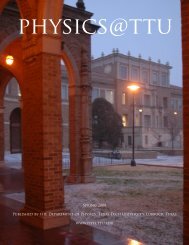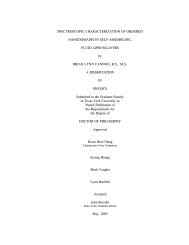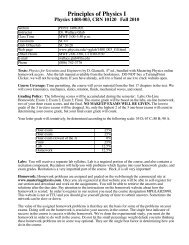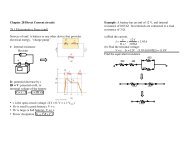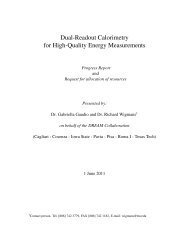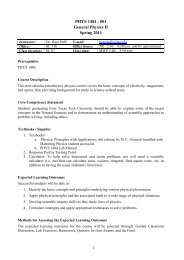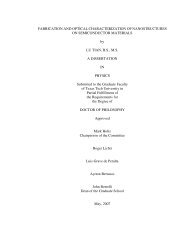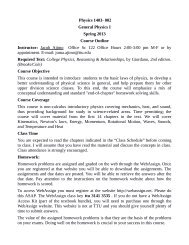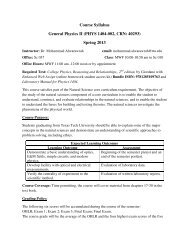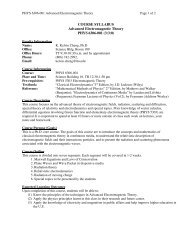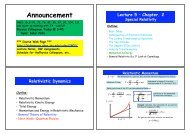Chapter 22 Electromagnetic Waves
Chapter 22 Electromagnetic Waves
Chapter 22 Electromagnetic Waves
You also want an ePaper? Increase the reach of your titles
YUMPU automatically turns print PDFs into web optimized ePapers that Google loves.
<strong>Chapter</strong> <strong>22</strong><br />
<strong>Electromagnetic</strong> <strong>Waves</strong>
Units of <strong>Chapter</strong> <strong>22</strong><br />
• Changing Electric Fields Produce Magnetic Fields;<br />
Maxwell’s Equations<br />
• Production of <strong>Electromagnetic</strong> <strong>Waves</strong><br />
• Light as an <strong>Electromagnetic</strong> Wave and the<br />
<strong>Electromagnetic</strong> Spectrum<br />
• Measuring the Speed of Light<br />
• Energy in EM <strong>Waves</strong><br />
• Momentum Transfer and Radiation Pressure<br />
• Radio and Television; Wireless Communication
Changing Electric Fields Produce Magnetic<br />
Fields; Maxwell’s Equations<br />
Maxwell’s equations are the basic equations of<br />
electromagnetism. They involve calculus; here is a<br />
summary:<br />
• Gauss’s law relates electric field to charge<br />
• A law stating there are no magnetic “charges”<br />
• A changing magnetic field produces an electric<br />
field (Faraday’s law)<br />
• A magnetic field is produced by an electric current,<br />
and also by a changing electric field (Ampère’s law)
Changing Electric Fields Produce Magnetic<br />
Fields; Maxwell’s Equations<br />
Only one part of this is new – that a changing<br />
electric field produces a magnetic field.<br />
Ampère’s law is modified to include the creation of<br />
a magnetic field by a changing electric field.
Production of <strong>Electromagnetic</strong> <strong>Waves</strong><br />
Since a changing electric field produces a magnetic<br />
field, and a changing magnetic field produces an<br />
electric field (Faraday’s law), the result is a wave of<br />
electric and magnetic fields that can propagate (travel)<br />
through space.<br />
These propagating<br />
fields are called<br />
electromagnetic waves.
Production of <strong>Electromagnetic</strong> <strong>Waves</strong><br />
Oscillating charges ( or oscillating currents ) will<br />
produce electromagnetic waves:
Production of <strong>Electromagnetic</strong> <strong>Waves</strong><br />
Radiation field:<br />
1)<br />
( E ⊥ B)<br />
⊥ v<br />
2) E and B are in phase<br />
3) Far from the source, the waves are plane waves
Production of <strong>Electromagnetic</strong> <strong>Waves</strong><br />
The electric and magnetic waves are perpendicular<br />
to each other, and to the direction of propagation.<br />
Sinusoidal voltage source<br />
E and B.<br />
sinusoidally varying
Production of <strong>Electromagnetic</strong> <strong>Waves</strong><br />
When Maxwell calculated the speed of propagation<br />
of electromagnetic waves in empty space, he found:<br />
This is the speed of light in a vacuum.
Light as an <strong>Electromagnetic</strong> Wave and the<br />
<strong>Electromagnetic</strong> Spectrum<br />
Light was known to be a wave; after producing<br />
electromagnetic waves of other frequencies, and<br />
showing that EM waves exhibits all characteristics<br />
of light (reflection, refraction and interference), it<br />
was known to be an electromagnetic wave as well.<br />
The frequency of an electromagnetic wave is<br />
related to its wavelength:
Light as an <strong>Electromagnetic</strong> Wave and the<br />
<strong>Electromagnetic</strong> Spectrum<br />
<strong>Electromagnetic</strong> waves can have any wavelength;<br />
we have given different names to different parts of<br />
the wavelength spectrum.
Measuring the Speed of Light<br />
The speed of light was known to be very large,<br />
although careful studies of the orbits of Jupiter’s<br />
moons showed that it is finite.<br />
One important measurement, by Michelson, used a<br />
rotating mirror:
Measuring the Speed of Light<br />
Over the years, measurements have become more<br />
and more precise; now the speed of light is defined<br />
to be:<br />
This is then used to define the meter.
Summary of <strong>Chapter</strong> <strong>22</strong><br />
• Maxwell’s equations are the basic equations of<br />
electromagnetism<br />
• <strong>Electromagnetic</strong> waves are produced by<br />
accelerating charges; the propagation speed is<br />
given by:<br />
• The fields are perpendicular to each other and<br />
to the direction of propagation.
Summary of <strong>Chapter</strong> <strong>22</strong><br />
• The wavelength and frequency of EM waves<br />
are related:<br />
• The electromagnetic spectrum includes all<br />
wavelengths, from radio waves through<br />
visible light to gamma rays.



